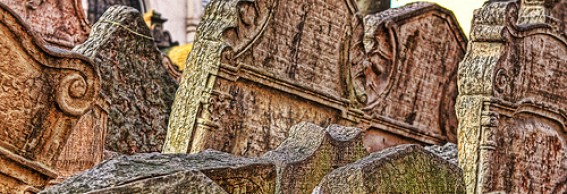2005
(Photo: Old Jewish Cemetery, Prague)
Budapest is a modern alloy, a fusion of medieval villages divided by the Danube. Last May, on our first morning in the city, Arlyne and I rode the old blue railcars of the subway under the river to the base of the Varhegy, or Castle Hill, on the Buda side of the water. A few cobblestone switchbacks took us through banks, apartments and artisan windows, until we found the shaded stairway rising to Saint Matthias Church, still the crown of the old city. Here, at the end of the ten-day journey, the College Choir would perform its final concert—in a church once ruled, for more than a century, by Muslim imams.
Built in the 1300s, Saint Matthias has had an eclectic history, not unlike its prismatic roof. Even today the cathedral must share its precipice with twentieth-century partners. Next to the cathedral a postmodern Hilton has been fitted into the remnants of a crumbled monastery. Along the cliff's edge, the hotel's bronze windows and thin metal coronets pay only half-hearted allegiance to its ancient setting—a rich new in-law puncturing the old family's pride. Far less brazen, the winding stairs of the Fisherman's Bastion evoke the old medieval walls, even with some fairy-tale indulgence. Constructed shortly after World War I, the Bastion spreads over the ledge once frequented by fishermen who sold their catch outside the cathedral doors.
The mood of the Hungarian capital now appears bright and entrepreneurial, but the pages of local history have their blood-stained edges. Across the Danube, in the old city of Pest, the Soviet star once flew above the House of Parliament. Student protestors, angered by the Soviet stranglehold, were once gunned down in the cathedral square. Well before World War II, the city was a cosmopolitan center, a haven for several displaced peoples, including a large aggregate of Jews, many of whom disappeared during the last World War. In the National Museum there are old photos of Nazi soldiers stationed all along the Bastion's walls. Gypsies—once quarantined and murdered by Nazis and Communists—now sell handicrafts nearby in the open market or push tourist books in the square where thousands of political and religious rivals over the years have lost their lives.
For nearly a century and a half, when the Christians fell to the Turks, Saint Matthias served as a mosque. Inside the sanctuary, the Turkish past is brought to mind by the frescos that surround the biblical and medieval saints with Byzantine designs, spilling across the ceiling and pillars. About twilight, as the concert neared its finale, the choir hit its emotional crest with a melancholy refrain by René Clausen:
Set me as a seal upon your heart,
A seal upon your heart,
For love is as strong as death . . .
These are words from the Song of Solomon, perhaps the most elusive of all the selections in the Hebrew canon. Christians have always been uncertain how to read this love poem—to claim it as an allegorical portent of New Testament atonement or to accept it as an expression of Hebrew sensuality, perhaps with artistic roots as deep as Egypt. The Song of Solomon has always tested our capacity to understand the syncretic nature of our own traditions. How do we, with historical care, heed the poetic and prophetic power of the language even as we hear the echoes of pre-Christian cultures? What does it mean today to walk over ecclesiastical stones once claimed by Muslims, Catholics and the secret police?
Ten days before we entered Budapest, we walked through the Old Jewish Cemetery in Prague, not far from the headless statue of Franz Kafka. On the tops of the tombstones small stones filled the ragged granite—an ancient Hebrew ritual of prayer. Squeezed at all angles between the thick roots of the trees, hundreds of gravestones tell the names of just a fraction of the Jewish dead buried here. Six centuries of the Diaspora lie beneath the overwrought earth. There are far more names, nearly thirty thousand, in the adjacent Memorial building, a chillingly bland ledger of the Bohemians and Moravian Jews lost during the purges of World War II. Not all that long ago former secretary of state Madeleine Albright discovered her grandparents' names on the Memorial's walls. That night, after we returned to our hotel, we watched Albright on the BBC lament the latest exchange of life in the Palestinian-Israeli fury.
Twice now Arlyne and I have traveled with the choir on its European travels, listening to its varied repertoire—folk anthems, baroque hymns, American spirituals—sung in the great European cathedrals. Somehow, the acoustics of the old stones give new vitality to faith: Bach in his familiar naves and chancels, Aaron Copland venturing into the vast gothic spaces overhead. Here American enthusiasm meets European antiquity, each compensating in some measure for the other. But a trip through Europe veers, inevitably, into the backstreet corners and public corridors where Christians, Jews and Muslims have spilled each other's blood. For the most part, America lacks those tragic symbolic spaces—except one. Not long after bin Laden's Sayyid Qutb extremists slammed planes into the towers Americans rushed forward with pleas for revenge. Sales of the Qu’ran escalated. Conversions to Islam actually increased. Some Christian and Jewish politicians urged restraint and issued apologies when mosques were defaced or Muslims threatened. Several called for self-control—the hard discipline of understanding and study before fear gained the upper hand.
Those appeals, though, are less frequent, at least in the major American media that so often serve as our public square. Returning from Budapest and Prague, I have thought more about the importance of interfaith dialogue on Christian campuses. Such conversations have never flourished at evangelical colleges. In many respects, they still appear an anathema, a retreat from the Great Commission. For many believers, what looms for them at the end of the interfaith conversation is a pale spirituality, a plea for tolerance rather than conviction. It is an agenda more likely to be heard among the agendas of the mainline churches than among the centers of evangelical and Pentecostal expansion throughout the world.
But it is a conversation that seems every day more necessary. Among the most compelling challenges of the next generation will be the struggle to live in a world where Christianity and Islam are flourishing and colliding. What do we need to prepare for that future? To start, we may need more courage to read and listen to the tragic narratives of historical violence and delusion. Whatever one fears about interfaith dialogue as a dilution of faith, a far more anemic modern impulse is to avoid talking about death, to erase the tragic from our public rhetoric about faith and practice. History and story matter, especially to those whose suffering is inexplicable in moral terms. And we all need a deeper awareness of the intellectual tenets within all religious traditions that both impede and advance social hope—those ideas that discourage insularity, check anger and impulse, and offer ideas for the amelioration of ethnic and social rage.
Perhaps no American spoke more compellingly about the mixture of tragedy and hope among believers of all faiths than Martin Luther King, Jr. The man who proclaimed that his dream for racial justice was "deeply rooted in the American dream" also knew that the tragedy of African-American slavery and discrimination was deeply rooted in the American tale. He knew the stories—from the bleakest scenes of the Middle Passage and chattel slavery to the more subtle forms of modern racial condescension—needing to be retold. But he also drew from his own Christian faith the principles and metaphors that resisted the debilitating cycles of retaliation, advocated for both resilience and patience, and restored the dignity of those created in God's image.
King met some of those images of God on tour in southern India, in the village of Trivandrum, where he was branded a "fellow untouchable," an American brother to the thousands sleeping in shacks with their chickens and cows. As a Christian, he could praise "the wonderful spiritual quality of the Indian people . . . who were poor, jammed together and half starved, but they did not take it out on each other." With confidence of his own faith, he walked into interfaith conversations and saluted, with a prophetic intuition, the work of other religious leaders—Jews, Hindus and Muslims—who drew from their own traditions the principles of peace and reconciliation. Gandhi, of course, was an enduring influence, a victim himself of interfaith wrath. In "the philosophy of Gandhi," King once wrote, "my skepticism concerning the power of love gradually diminished." That reading rekindled his seminary studies, helping him "lift the love ethic of Jesus above mere interaction between individuals to a powerful and effective social force on a large scale." Aware that the African-Americans had long invoked the Hebrew exodus as their own reservoir of comfort and hope, King saw a "unique relationship" between the "urban Negro" and the Jews. With a courageous candor, he acknowledged how a few examples of "Negro anti-Semitism" had contributed to the "social poison." But he also used the occasion to urge all to avoid the "tragic and immoral mistake" of branding other races and creeds with "cheap and dishonest slogans" because of the behavior of their most "frustrated and irrational" members and proponents. He ventured into the difficult terrain where cultures and creeds clashed, without bargaining away his own inheritance as a Christian witness and an African-American man. And while the route out of violence was not always visible, he clung to the promise of his faith, even as he took counsel from beyond his own culture and borders.
Now his story belongs to the world. Today the image of King stares out from Asian, African and European windows. I saw it at a Budapest bookstore and at a Prague café near Wenceslas Square, the site where Václaz Havel and thousands of Czechs sang into the autumn night to mark the nonviolent end of the "Velvet Revolution." King died in 1968, still in the morning of his middle age, even as the short-lived brilliance of the Prague Spring gave way to the tempest of Soviet tanks. Yet what he wrote to the Southern pastors from Birmingham Jail would sustain Havel during his many months awaiting trial in Prague's Ruzyne Prison.
Last Saturday, as I rode the red line to Ashmont Station for a dinner with the Boston Urban Program, a flyer for a Martin Luther King Day service rested nearby on an empty subway seat. Not long ago, in the pedestrian tunnel at Downtown Crossing, I heard a single acoustic guitar player sing "We Shall Overcome." Today, that day of memory, there are hundreds of the faithful in the brownstone sanctuaries of Dorchester, Roxbury and Lynn but greater stillness within the white-steepled, snow-fringed clapboard on the North Shore. This is a holiday that could, without care, become isolated from our stories of nation and faith, a commemoration that remains vibrant in African-American churches but less relevant elsewhere. The danger is that King will become a ritual about an ethnic struggle in the American South that grows further distant each year in our collective memories. At a Christian institution, we need to see the day less as a detour from our current preoccupations or simply as a tribute to the past, but as an occasion that continually enlarges our moral and intellectual scope. In King, we find not merely one of the great martyrs of the Sixties, but one of the few Christian voices on the international stage who tried to proclaim, without passivity or naiveté, that love among people of all faiths—empathy, perseverance, truth-telling and grace—could be as strong as death.


 Essays about Gordon
Essays about Gordon


